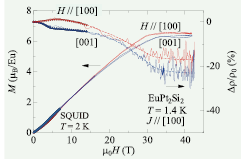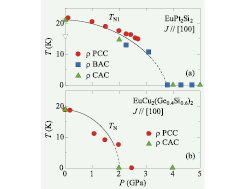Heavy-Fermion State in Valence-Fluctuating Antiferromagnetic Compound EuPt2Si2 under High Magnetic Field and High Pressure
T. Takeuchi, Y. Ōnuki, and T. Kida
EuPt2Si2 crystallizes in the CaBe2Ge2-type tetragonal crystal structure and is known as a valence-fluctuating compound. From the χ(T) measurement of polycrystalline samples, it is found that EuPt2Si2 orders antiferromagnetically at TN = 15 K. χ(T) at high temperatures follows the Curie-Weiss law with an effective magnetic moment of μeff = 7.7 μB/Eu, indicating that the Eu ions are essentially divalent. Here, μeff for the Eu2+ free-ion is 7.94 μB/Eu. On the other hand, an unusual broadening of the Mössbauer resonance line width is observed below about 100 K, suggesting that the valence is fluctuating and already deviates slightly from divalent to trivalent at room temperature. One of the intriguing findings for EuPt2Si2 is the -lnT dependence of ρ(T) below T ≃100 K. In addition, the magnetic entropy of Smag ≃ 0.6Rln8 below TN and the strongly enhanced γ ≃ 200 mJ/(K2·mol) suggest that a heavy-fermion state is realized at low temperatures in EuPt2Si2.

Fig. 1. High-field magnetization curves M(H) (left-hand scale) and relative changes in the magnetoresistance Δρ/ρ0 for J // [100] (right-hand scale) in magnetic fields applied parallel to the [100] and [001] directions at 1.4 K. The M(H) data below 7 T were measured in static magnetic fields using a SQUID magnetometer at 2 K. The Δρ/ρ0 curves below 14 T were measured using a superconducting magnet. Broken lines for Δρ/ρ0 at high magnetic fields are guides to the eye.

Fig. 2. Comparison of the P–T phase diagrams for EuPt2Si2 and EuCu2(Ge0.4Si0.6)2, cited from Ref. [2]. The P–T phase diagram for EuCu2(Ge0.4Si0.6)2 was obtained by the resistivity measurements for J // [100] under pressures. PCC, BAC, and CAC denote piston cylinder cell, Bridgman anvil cell, and cubic anvil cell.
To obtain more insight into the heavy-fermion features in EuPt2Si2, we grew single crystals of this compound and studied the effects of a magnetic field as well as pressure on its magnetic properties.
The single crystal of EuPt2Si2 shows two antiferromagnetic transitions at TN1 = 21 K and TN2 = 16 K. The -lnT dependence of ρ(T) was observed in the temperature range from TN1 to about 100 K, as observed in polycrystals. The effect of magnetic field on the -lnT dependence of ρ(T) is found to be very weak, with Δρ/ρ0 of only ~0.1% at μ0H = 8 T. Even at μ0H = 40 T, which was produced using a pulsed magnet, Δρ/ρ0 amounted to only -20%, as shown in Fig. 1. These results suggest that the Kondo-like behavior of EuPt2Si2 is rather stable against the application of magnetic field, which is in contrast to the Ce-based heavy-fermion compounds.
On the other hand, the pressure markedly shifts the -ln T dependence of ρ(T) to higher temperatures, and TN1 is gradually decreased and suppressed to zero above P ≃ 4 GPa, as indicated in Fig. 2. From the comparison of the observed magnetic, electronic, and thermal properties of EuPt2Si2 with those of the well studied EuCu2(Ge0.4Si0.6)2,[2] the anomalous features observed below 100 K in ρ(T), S(T), and ΔV/V for EuPt2Si2 are most likely to be due to the valence fluctuation of the Eu ions. As a future problem, X-ray absorption and Mössbauer experiments are desirable to confirm the temperature dependence of the Eu valence in EuPt2Si2.
References
- [1] T. Takeuchi et al., J. Phys. Soc. Jpn. 87, 074709 (2018).
- [2] W. Iha et al., J Phys. Soc. Jpn. 87, 064706 (2018).
